Canine companion or beach predator?
Different Councils up and down the east coast of Tasmania have dog management plans for their municipality. Those dog management plans include the beaches as no-go beaches for dogs.
Dogs are prohibited, or they have to stay on a lead at all times. In some cases where there are no birds left on those beaches it's a dog off lead area - do whatever you like because the dog can't trash anything anymore on that beach.
This coastal management is data driven and evidence based, and so the councils are really good, the Parks and Wildlife Service is really good.
The problem is the dog owners refuse to accept that their dog is a problem and so they say "I've never seen a nest on a beach, I don't think there are birds nesting on this beach." Then they ignore the restrictions.
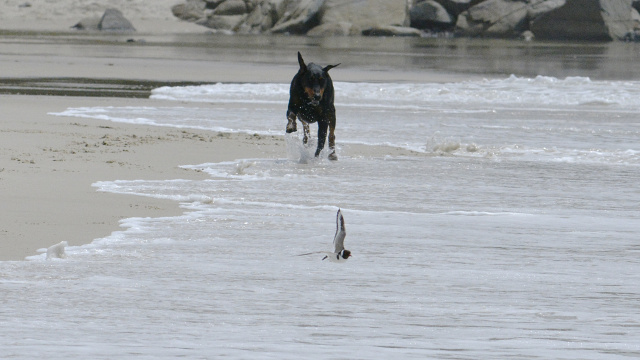
Hooded plovers and pied oystercatchers see dogs as predators. So the strategy that all shorebirds adopt is that they will walk away from a nest - eggs or chicks or whatever, because they can always lay another clutch of eggs and start again.
These birds will walk off the nest, potentially sacrificing eggs and chicks. It sounds crazy, but it's a widely used strategy.
Whereas, if you kill the adult, you're losing the breeding potential for that bird.
There has been work done at Deakin University in Melbourne that shows what are called flight initiation distances or FIDS.
For a hooded plover, it can be anything between 50 and 150 metres.
So if you're walking towards the nest that's 150 metres away, there are some hooded plovers that will walk off the nest, potentially exposing their eggs or chicks to predators or exposure at a higher level.
Given that very few beaches are 150 metres wide, it's not like you can walk past the nest far enough to not disturb the birds. And so it's simply the presence of dogs, the presence of people - that's enough to disturb the nesting birds. Even if a dog is on a lead, it will leave a scent trail for another dog that's not on a lead to follow.

We've identified high conservation value beaches, beaches that just have either good numbers of hooded plovers or other species that are threatened, and endangered.
Most people do the right thing if there's a sign that says 'please don't bring your dog on this beach or keep your dog on a lead'. But every now and then you get somebody who believes that their dog has greater priority.
And so we lose we lose our nesting shorebirds, or we lose a colony of terns.
So the rationale for the dog management plans in the different municipalities around Tasmania is that it's based on the survey data - and we try and keep those survey data as contemporary as current as we can.
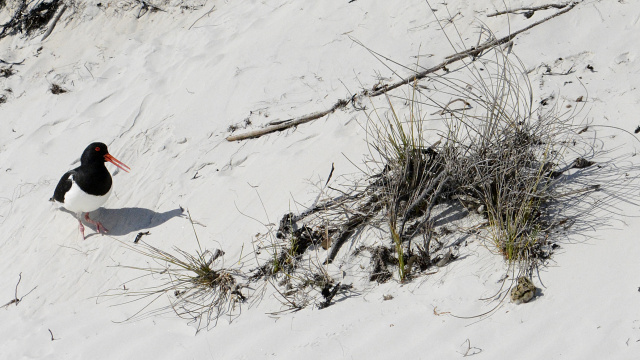
For every municipality where we've worked - and that's pretty much all the municipalities up and down the east coast, the southeast, King and Flinders Islands - we've identified dog beaches, we've identified dog off-lead, dog on-lead beaches.
In some cases the restrictions on dogs on beaches aren't actually for shorebirds or penguins or whatever else - the Councils have established dog restrictions for human recreational values, such as where people take their kids swimming, particularly during the summer months.
So the Councils have standardised their categories or zones for beaches around dog on lead, dog off lead, no dogs allowed, or restrictions around school holidays. Some councils send out maps with the rates and dog license renewals to alert dog owners.
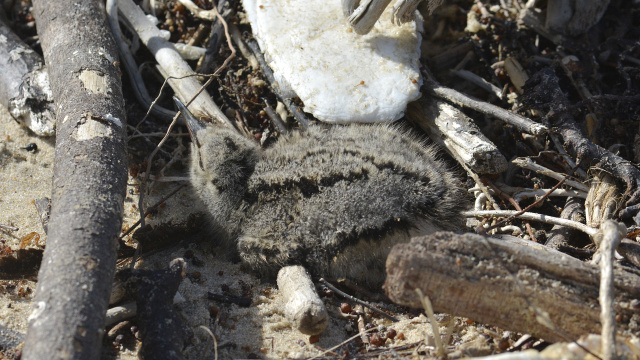
Those management plans, those dog plans are publicly available for every municipality. It's not like the information isn't available, it's just that many dog owners choose not to avail themselves of the information. Every species nesting on the beach is impacted.
Hooded plovers and pied oystercatchers are the two species that are really facing the biggest threats from dogs.
But there are also a couple of locations on Flinders Island, King Island and the east coast of Tasmania where we have fairy terns nesting.
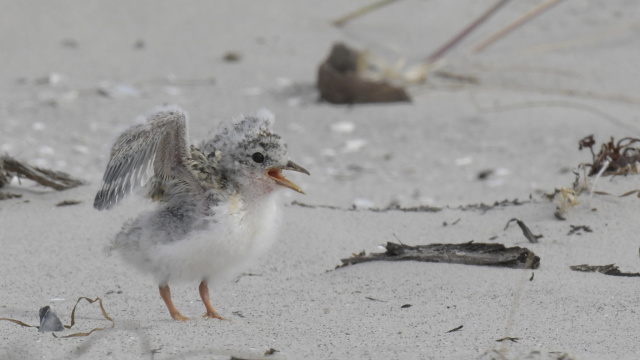
Everyone's probably familiar with a crested tern - it has a straw yellow bill and a black scraggly cap, about the same size as a silver gull. A fairy tern is the same size as a hooded plover, so it would sit comfortably in the cup of your hand. They're tiny little things.
They lay two eggs, just laying two eggs onto the sand.
We've had fairy tern colonies destroyed by deliberate dog attacks where people have deliberately let their dog loose to disturb the birds. That's totally unacceptable.
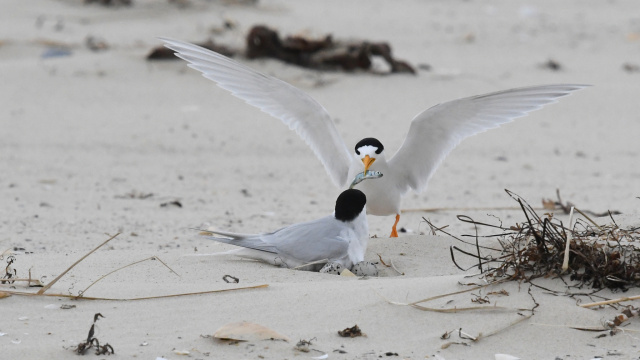
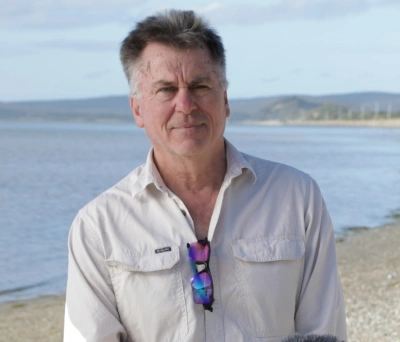
Dr Eric Woehler
Different Councils up and down the east coast of Tasmania have dog management plans for their municipality. Those dog management plans include the beaches as no-go beaches for dogs.
Dogs are prohibited, or they have to stay on a lead at all times. In some cases where there are no birds left on those beaches it's a dog off lead area - do whatever you like because the dog can't trash anything anymore on that beach.
This coastal management is data driven and evidence based, and so the councils are really good, the Parks and Wildlife Service is really good.
The problem is the dog owners refuse to accept that their dog is a problem and so they say "I've never seen a nest on a beach, I don't think there are birds nesting on this beach." Then they ignore the restrictions.

Hooded plovers and pied oystercatchers see dogs as predators. So the strategy that all shorebirds adopt is that they will walk away from a nest - eggs or chicks or whatever, because they can always lay another clutch of eggs and start again.
These birds will walk off the nest, potentially sacrificing eggs and chicks. It sounds crazy, but it's a widely used strategy.
Whereas, if you kill the adult, you're losing the breeding potential for that bird.
There has been work done at Deakin University in Melbourne that shows what are called flight initiation distances or FIDS.
For a hooded plover, it can be anything between 50 and 150 metres.
So if you're walking towards the nest that's 150 metres away, there are some hooded plovers that will walk off the nest, potentially exposing their eggs or chicks to predators or exposure at a higher level.
Given that very few beaches are 150 metres wide, it's not like you can walk past the nest far enough to not disturb the birds. And so it's simply the presence of dogs, the presence of people - that's enough to disturb the nesting birds. Even if a dog is on a lead, it will leave a scent trail for another dog that's not on a lead to follow.

We've identified high conservation value beaches, beaches that just have either good numbers of hooded plovers or other species that are threatened, and endangered.
Most people do the right thing if there's a sign that says 'please don't bring your dog on this beach or keep your dog on a lead'. But every now and then you get somebody who believes that their dog has greater priority.
And so we lose we lose our nesting shorebirds, or we lose a colony of terns.
So the rationale for the dog management plans in the different municipalities around Tasmania is that it's based on the survey data - and we try and keep those survey data as contemporary as current as we can.

For every municipality where we've worked - and that's pretty much all the municipalities up and down the east coast, the southeast, King and Flinders Islands - we've identified dog beaches, we've identified dog off-lead, dog on-lead beaches.
In some cases the restrictions on dogs on beaches aren't actually for shorebirds or penguins or whatever else - the Councils have established dog restrictions for human recreational values, such as where people take their kids swimming, particularly during the summer months.
So the Councils have standardised their categories or zones for beaches around dog on lead, dog off lead, no dogs allowed, or restrictions around school holidays. Some councils send out maps with the rates and dog license renewals to alert dog owners.

Those management plans, those dog plans are publicly available for every municipality. It's not like the information isn't available, it's just that many dog owners choose not to avail themselves of the information. Every species nesting on the beach is impacted.
Hooded plovers and pied oystercatchers are the two species that are really facing the biggest threats from dogs.
But there are also a couple of locations on Flinders Island, King Island and the east coast of Tasmania where we have fairy terns nesting.

Everyone's probably familiar with a crested tern - it has a straw yellow bill and a black scraggly cap, about the same size as a silver gull. A fairy tern is the same size as a hooded plover, so it would sit comfortably in the cup of your hand. They're tiny little things.
They lay two eggs, just laying two eggs onto the sand.
We've had fairy tern colonies destroyed by deliberate dog attacks where people have deliberately let their dog loose to disturb the birds. That's totally unacceptable.

You might like...

Plight of the shorebirds

The great Tasmanian bird count

Bruny Island launch: Cat Davidson on falling in love with Nature

A lifelong love for wildlife
Newsletter
Sign up to keep in touch with articles, updates, events or news from Kuno, your platform for nature
